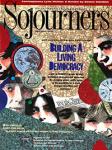WALKING UP the quarter mile from the bus stop -- past stone farmhouses, pastures filled with bleating sheep, vineyards, and a small Romanesque church -- it's easy to feel gloriously immersed in the countryside, to breathe in the wonderful stillness of the hills.
As you enter Taize -- a small village nestled in the hills of France's Burgundy region, where a monastic-styled community of brothers lives together -- the same peacefulness prevails. It is mixed here, though, with the vibrancy of shared lives, work, prayer, and a spirit of searching.
On the surface, there's not much to Taize: a few stark barracks and oversized tents, an institutional-sized kitchen serving the simplest of food, and a plain church that looks, from the outside, more like a gymnasium. Yet the bright murals scattered throughout the common areas, depicting scenes from everyday life in cultures around the world, give a hint of what makes Taize so special.
Every year, thousands of Christians come here -- from all over Europe, as well as from countries as far away as Chile, South Africa, Malaysia, India, and Canada -- on what is termed a "pilgrimage of trust," to search together for the "wellsprings" of their faith. These meetings are structured from Sunday to Sunday, and from March to November Taize is bustling with anywhere from 400 to 4,000 people.
The majority of these visitors are young people between the ages of 17 and 30, although Taize is open to people of all ages. Most who come stay only a week; some of the under-30 crowd, however, are invited to stay up to a year in their search for personal clarity and direction. The basic thing that unites everyone who comes here is a spirit of openness and searching; faiths are shared rather than debated, with the underlying assumption that everyone has a unique perspective worth listening to. Prayer and discussion take place in a variety of languages, so that as you stroll around Taize, a medley of voices and accents fills the air, making the world seem just a little bit smaller.
BROTHER ROGER, THE FOUNDER and prior of Taize, came here from Switzerland in 1940, during the second World War. He intentionally came to a place where the need for reconciliation was strong: the border dividing free and Nazi-occupied France. He began welcoming and hiding Jewish refugees into his home, from the outset maintaining the conviction that "the more a person wants to live in the absolute of God, the more essential it is for this absolute to be rooted in the midst of human suffering."
Forced to stay away for two years after a Gestapo invasion in 1942, Brother Roger returned in 1944 with a few students who became the first "brothers" of Taize. Their commitment to ecumenism -- which makes Taize so unique among monasteries today -- meant that they needed to create a new community rather than join an already-existing monastic order. In 1949 seven of them took lifelong monastic vows including agreement to community life, community of goods, and celibacy. The group of brothers has slowly expanded over the years to a current total of about 90, made up of both Catholics and Protestants.
In those early days, no one could have imagined that Taize would eventually welcome thousands of visitors each week to stay at the monastery. In fact, from the beginning, Brother Roger did not intend for regular meetings to be a part of Taize's ministry; he envisioned only a small group of people who lived and worked together as a monastic-style community. In 1957, though, a group of people asked to stay at Taize for a few days. Brother Roger's first inclination was to refuse, but eventually he agreed to set up a house a few kilometers away to welcome the visitors. Later a house was built closer to the community and meetings became a regular part of Taize.
The brothers of Taize now see the welcoming of young people as an essential part of their vocation. The meetings that take place focus on the union of inner life and human solidarity, in the context of a world filled with suffering and desperately in need of reconciliation. Instead of attempting to give answers to people, the brothers see their role as encouraging visitors to go to the sources of their own faith.
Daily life at Taize is designed to provide an environment helpful for this kind of searching. Three times a day the brothers and the visitors participate in common prayer in the large, candle-lit Church of Reconciliation. Worshipers sing psalms, listen to passages from the Bible in various languages, and spend a long period of time in silence. The prayers conclude with simple, meditative songs -- vaguely resembling Gregorian chants -- which have become one of the hallmarks of Taize.
Visitors to Taize spend the rest of their days working together around the monastery, in biblical introductions (led by one of the brothers), and in small reflection groups. There are also entire afternoons (or more) blocked out for silence. These are times to reflect on the inner questions which the discussions raise, questions related to what it means to be a "bearer of reconciliation" in the world today.
ANOTHER IMPORTANT ELEMENT of Brother Roger's original call was the commitment to "reach outward," beyond the borders of the monastery itself. In fact as early as 1951 he helped form a union among mine workers in a nearby village. The "outward" focus continues to be a priority in the ministries of Taize; about a third of the brothers now live around the world in various projects, in places such as Brazil, Bangladesh, Kenya, Korea, and New York City (where a small group lives in a neighborhood called "Hell's Kitchen"). The goal of these projects, according to Brother Emile who lives year-round at Taize, is essentially "to share the lives of the people there, to express that there is one human family, and to be a presence, a sign of joy and simplicity."
The commitment to reach outward has also led to larger meetings which take place at least once each year in various European cities. These began in Paris in 1978, and have since occurred in Barcelona, Rome, London, Cologne, and most recently Wroclaw, Poland. The European meetings typically draw up to 30,000 "pilgrims," many of whom have visited Taize in the past. Participants are welcomed by local churches, families, and parishes. The meeting in Poland last year was the largest to date; 50,000 people were welcomed into Polish families.
Larger meetings have been cropping up outside of Europe as well. In 1985, Catholic and Protestant bishops in south India, moved by Taize's efforts to unite rather than separate inner life and human solidarity, invited some brothers to organize a youth meeting in Madras. After 18 months of preparation -- traveling throughout India to remote areas and villages to educate themselves and form connections -- a group of brothers organized a meeting of 15,000 young people from all over India, as well as from 25 other Asian countries. A similar meeting was held again in Madras in 1988.
Experiences like these have led to more intentional efforts to bring an "intercontinental" focus to the weekly meetings at Taize. Bishops from India as well as other developing countries now send Christian youth leaders for three-month stays at Taize. During these visits, these young people make daily presentations at the monastery itself as well as in parishes throughout Europe.
Remarkably, the community accepts no gifts to sustain itself, and it holds no capital in reserve. The brothers -- both at Taize and in the projects around the world -- live totally supported by their own work, including pottery (sold only at the monastery) and books and pamphlets published on their printing press ("Les Presses de Taize").
Each brother contributes to the life of the community depending on his individual gifts: writing, organizing meetings, making pottery or stained glass, or speaking to groups.
LIFE AT TAIZE, WHILE NOT AS RIGID or structured as life in an ordinary monastery, does have a monastic flavor. The brothers recognize the ministry of the prior, Brother Roger, who expresses decisions of the community after prayer and consultation with the other brothers. Unlike traditional monastic orders, they do not have a long list of constitutions that they follow; Brother Emile explains, "We feel there needs to be room to change, to be creative."
Such creativity is reflected in the brothers' hesitancy to formulate a collective vision beyond one year into the future. Once a year they hold a council where they talk and pray together about how to announce a gospel of trust and reconciliation in the world today. This year, for instance, their energies have been increasingly focused around the recent upheaval in Eastern Europe, which they had been anticipating for some time.
Another area where Taize's ministry has been evolving has been the place of women in the community. Taize is essentially a community of brothers; and one of the drawbacks of monastic life, as the brothers acknowledge, is the limitations it places on ministry to women. Over the years, an increasing number of visitors are women, and women now make up half of the "permanents" (those people who are invited to work at Taize for longer periods of time). Women share in the responsibilities of preparing the meetings, both within and outside of the community.
Nevertheless, women are not part of the permanent community of brothers, and this carries a certain tension for many. Taize has been helped in this respect, however, by the presence of the Sisters of Saint Andrew, who came to the area in 1966 and share in the responsibilities of welcoming people to Taize and accompanying them in their search. The sisters maintain their own community in a neighboring village, but they have over the years become more and more a part of the activities of Taize. Many young women who have been "permanents" at Taize go on to make lasting commitments to the community of sisters.
THE ESSENCE OF TAIZE, the reason people return to this place again and again, is hard to verbalize; yet there is a sense that the kind of searching that goes on within the limits of this community is profound and life-changing for many who come. Friendships form quickly and solidly here, as so many aspects of daily life -- work, prayer, meals -- are shared by all.
Zrinka Zubic, a 24-year-old visitor from Yugoslavia, reflects on this feeling of connection: "At Taize I always make friends from all over the world -- and we're connected in Christ, in prayer. It's a place where you can meet, and stop a bit -- and listen to God."
The brothers hope that people will leave Taize with an increased understanding of their ability "to build trust between people of different generations, or with different opinions, to build trust across the rifts between Christians of different backgrounds and between people of different cultures."
Luc Tanja, a second-year political science student from the Netherlands who has visited Taize several times, has discovered that sense of trust: "Here at Taize I can trust myself. I can trust myself to dare to be open with others -- because there are so many here who dare to be open with me. I am gradually learning to communicate with people as I never could before."
Perhaps it is this trust -- this ability to risk -- that continues to draw people back to Taize. Pope John Paul II once said, "One passes through Taize as one passes close to a spring of water." Certainly a deep sense of renewal arid refreshment stays with those who visit Taize -- long after the visit is over.
Karen Peterson was editorial assistant at Sojourners when this article appeared.

Got something to say about what you're reading? We value your feedback!
